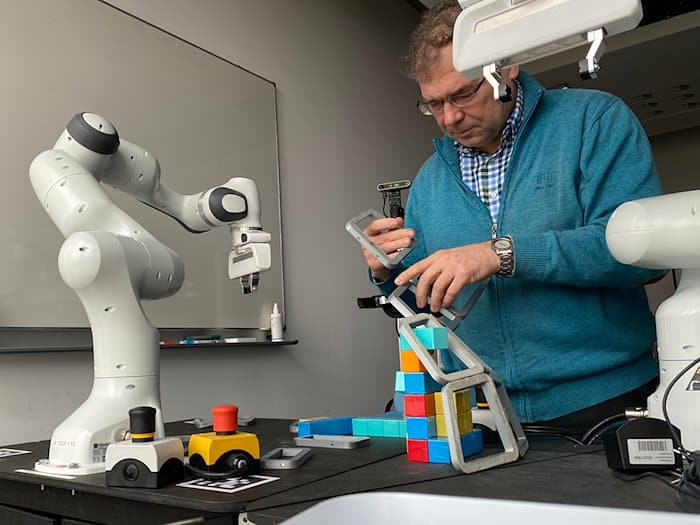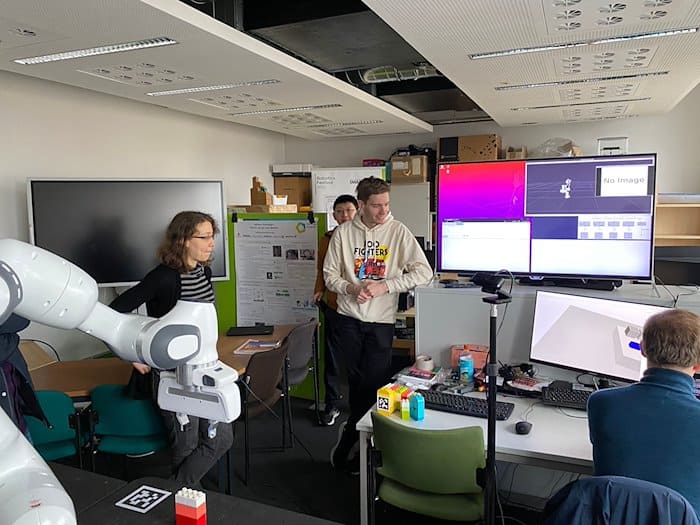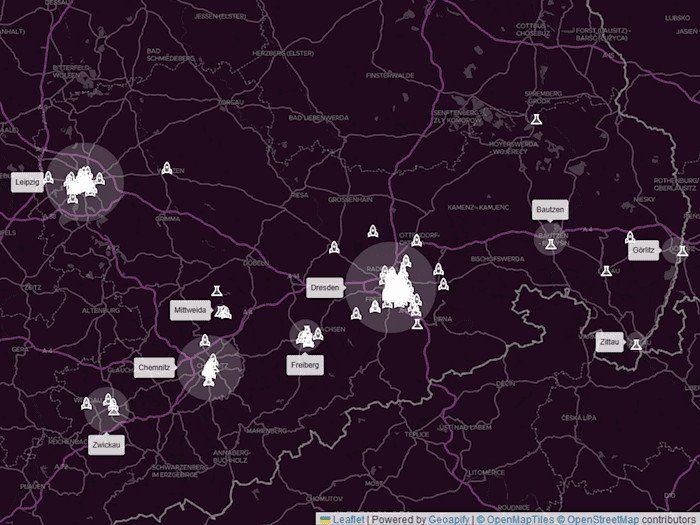In an interview with Prof. Uwe Aßmann (Chair of Software Technology, TU Dresden), we talked about Saxony’s strengths, missed opportunities, necessary measures and the power of InnoTeams.
Categories
In an interview with Prof. Uwe Aßmann (Chair of Software Technology, TU Dresden), we talked about Saxony’s strengths, missed opportunities, necessary measures and the power of InnoTeams.

Categories
Tags
Contact info
Silicon Saxony
Marketing, Kommunikation und Öffentlichkeitsarbeit
Manfred-von-Ardenne-Ring 20 F
Fax: +49 351 8925 889
Contact person:
The software location has developed strongly. Saxony’s software industry is growing the fastest of all industries, which is reflected in the number of employees and the successful establishment of start-ups, among other things. SMEs are also continuing to grow. Not as fast as we would like, but at least it is living off its own resources and will continue to provide jobs. The current labor market figures from Silicon Saxony confirm this. In fact, we will already be a software country with more than 50,000 jobs by 2030, which is great.
All in all, things could look even better if politicians would listen to us a little more and take more inspiration from successful examples such as Munich, Stuttgart or Karlsruhe. Because they show that you can catalyze technology transfer and start-up processes very well if you promote the right success factors.
For example, the TU Dresden campus lacks a technology center because it has not yet been funded. Our hopes are now pinned on the Lehmann Center office building, directly behind my faculty. We hope to bring together many of the TU’s digitalization institutes here and set up a small incubator, but it’s still a long way from being a technology center. New living labs such as a cobotics lab, an immersion lab, a maker lab for sensor technology and an incubation area are also to be created. Ideally, we will then be able to support the transfer much better with the new building from 2027/2028. A similar project, the Smart Mobility Lab, will be completed in Lusatia in 2026. This is a huge hall for testing autonomous systems and is being built in cooperation between the Faculties of Computer Science, Transport Science and Mechanical Engineering. Such interdisciplinary test fields are extremely important. For example, to realize joint projects in which Saxon companies are also strategic partners or in which companies and research teams from the TU work together in InnoTeams.
In general, start-ups and fast-growing start-ups are essential for the growth of the location. That is why we are continuing to work on corresponding offers at the TU. The TUD|excite programme in cooperation with Professor Pinkwart from the Department of Economics, for example, aims to professionalize and support start-up processes to a greater extent.
Saxony is in a good position nationally thanks to its strong position in various niche markets and some “hidden champions”. These include Robotron RDS for energy information systems, Telekom MMS for web systems, Secunet for security software, Amazon Web Services (AWS) for web services and so on. However, there are challenges in scaling these companies. This is not so easy for hidden champions. That’s why Saxony needs more “gazelles”, i.e. start-ups that scale quickly, grow continuously over the years and then also have a large payout.
There are now positive developments thanks to improved funding structures and investment opportunities. Smart Infrastructure Ventures from Leipzig, SpinLab and the Technologie Gründerfonds (TGFS) are just a few examples.
Missed opportunities and wrong decisions in certain technological areas are having a negative impact. In the field of “Embedded Systems & Software”, for example, the state government has failed to attract research institutes to Saxony. As a result, the state has lost several years, also with regard to start-ups in this area.
Software components for cars, machines and cell phones unfortunately only play a subordinate role in Saxony’s industrial strategy. Strategic adjustments should definitely be made here, as the embedded systems sector continues to grow very strongly internationally. An alternative could be robotics, which is also growing at 25 percent per year.
With a science and transfer strategy for robotics, Saxony’s old dream of becoming a complete system manufacturer again could come true.
As already mentioned, there is no one unique selling point in Saxony. Rather, Saxon software companies have specialized in niche markets. In addition to the aforementioned fields of cloud, web services, security and energy, this includes the entire field of testing with testing software, tools and processes. One of our InnoTeams is currently working on a digital twin for real estate. If we succeed, then in five to seven years we will have a German market leader for this topic here in Saxony. That would be great, of course.
As you can see, together with the examples already mentioned, it is not possible to define a single market in which Saxony is strong.
Rather, it is perhaps the special feature of Saxon entrepreneurs and managing directors that they have managed to achieve a remarkable position in the market for their companies through skill and innovation – despite limited resources for venture capital.
Academic institutions are essential for technology transfer and the innovative strength of Saxony’s software industry. Collaboration with industry through joint projects and the integration of research into company development are key success factors. If you as a company do not make use of this “fresh blood” in the form of up-to-date knowledge, new ideas and motivated young people, sooner or later you will stew in your own juice. This makes innovation difficult.
In order to survive on the market in the long term, however, you need a new framework or a new product line for the products of the future every 10 to 15 years.
Programs such as our Saxon InnoTeams strengthen this connection and promote the exchange between university and industry. As far as I know, this is unique in Germany. InnoTeams are financed by European funds and can run for three years with up to twelve people, i.e. roughly pari passu between university and company.


Teamwork at the Professor of Software Engineering
In these teams, a company can collaborate with universities to address a strategic new topic or develop a prototype for a new product line. At the same time, the aim of the InnoTeam is to network the working groups in such a way that new employees are also hired as a result of this project. These new hires have an extremely high level of acceptance in the respective companies, ensure rejuvenation and continue to support the projects. I can only advise all software companies to talk to companies that have already done this.
When a company wants to transfer an idea from an advanced development project to product development, the product department is often reluctant to do so. This is simply a major human problem. We know it as the “not invented here” syndrome. This is exactly what our InnoTeams get around by promoting a combined transfer of knowledge and ideas. In this way, they bring research and development into companies as driving forces for innovation and competitiveness in the software industry and this ensures the continuous renewal of the technological basis of companies.
In addition to application-oriented research and the projects of our InnoTeams, we naturally also have basic research projects in which we look even further ahead in terms of technology. However, when people who have worked on such fundamental topics go into companies, the disruption is much greater. Although they then bring their forward-looking knowledge with them, they are usually unable to apply it directly in the company.
In my opinion, the biggest problem is that companies still have too little knowledge of modern business models in software.
They simply don’t know the success factors of product lines or software ecosystems and are therefore unable to scale.
The Americans are aware of these business models and are actively fighting for platforms for ecosystems. AI engines are a current example of this. You can still use ChatGPT and similar offerings free of charge. But once enough data has been collected, you can be sure that the software ecosystem business model will work.
Saxony is asleep here, but this is generally a German phenomenon.
The most ALEPH ALPHA can do here is play a tangential role. “Software is eating the world” doesn’t just mean that software is being built in everywhere, but that software business models are taking over value generation. That’s why every entrepreneur should get to grips with these issues.
At TU Dresden, for example, we run a “Software as a Business” course in which we train students in the lean startup process and modeling business models, which fortunately is very stable with around 20 students per year. I find the combination of both topics so appealing, because agile software engineering and agile business modeling also have to be thought of and implemented together in a start-up or company. My dream would also be an Entrepreneurial Master’s degree in Dresden, half of which would cover a specialist subject and the other half would teach start-up knowledge. The Leipzig Graduate School of Management has developed a very interesting training technology in recent years, which is also used in Saarbrücken, among other places. These courses bring a lot of the American way of thinking into the minds and thus the companies. In addition, students can set up companies extremely quickly, for example if their Master’s subject is a business model. Such degree programs will make the difference in the coming decades and I would be delighted if we also invested in appropriate training in Saxony.
The start-ups that we have supported with a mentoring program and that I particularly hope will continue to “fly” include DevBoost, Wandelbots, Mainteny and a few other smaller start-ups. If you study the Business Model Canvas, there are “Customer Segments” on one side and “Key Partners” on the other. On the customer side (“Customer Segments”), we can only provide limited support in Silicon Saxony because, as already mentioned, many of the major customers of our Saxon start-ups are based in the west and south of Germany. It depends on the entrepreneur’s personality and how diligently he or she makes contacts. However, we in Silicon Saxony can provide very good support in arranging and establishing partner relationships (“key partners”), for example through our “Start-up and Growth” working group.
_ _ _ _ _ _ _

_ _ _ _ _ _ _
In the Corona period, when we were frantically switching my teaching to video formats, we were surprised to find that the students still took very good exams.
That’s why I’m currently thinking about how we can tackle the topic of continuing education even better, because the industry’s needs are definitely there.
In principle, we could digitize all the courses we have here – even in the Master’s degree. Imagine if the software business start-up course “Software as a Business” was available online and you could book it individually from your company as further training. That would be great. But of course I can’t implement a “hybrid Masters” on my own.
Saxony must become attractive for the important minds in teaching, which primarily works by investing money sensibly and in the right places. Saarbrücken had such a “head” in Professor Scheer, the developer of ARIS, an architecture of integrated information systems, with which he succeeded in decisively shaping today’s understanding of business process management. But you also have to systematically attract and tap into these minds. Saxony is already doing this quite well with the Hightech Startbahn, the SpinLab in Leipzig and the Scaling Champions, but there is still room for improvement.
Saxony must also become more attractive for business angel networks and venture capitalists (VCs).
Business angels help start-ups to avoid mistakes, find markets and provide the all-important contacts.
All the start-ups I know of that were successful in Saxony had (individual) business angels. But access to the relevant networks is not so good in Saxony. In short: some kind of support for business angel networks would be great.
I could also imagine Saxon investments in start-ups (i.e. a kind of Saxon fund) that would be repaid after 10 years if the start-up is successful. Something like this does not yet exist in Germany, but it does at large American companies.
As a rule, a good computer science faculty focuses on the domains of the region through specialized professorships in application topics in order to provide skilled workers.
Unfortunately, education is not keeping pace with the growth of the software industry and this is slowly turning into a disaster for the labor market.
I have tried for 20 years to get specialized software engineering professorships in Dresden, such as “Automotive Software Engineering”, “Software Engineering for Robotics”, “Human-Machine-Interaction” and the like – to no avail. Despite the joint proposal of the “nu.digital” digitalization initiative in 2020, our faculties as a whole have not succeeded in this either. Fortunately, we have a very good embedded software professorship here in Dresden, but we have lost our professorship for factory simulation. I said before that the area of software testing is huge, but there is no corresponding professorship. The situation is not much better in the area of security-by-design. There are numerous proposals, but no money.
The centers for software security are located in Darmstadt, Munich and Saarbrücken and have been expanded with enormous resources.
You have to come up with something in Saxony if you want to build something here to support companies like Secunet, for example. Fortunately, after five years and three failed procedures, we have now been able to fill our single professorship for “Privacy and Security” with an excellent candidate – but that clearly shows how tight the market for professorships in the field of security is at the moment! So much more needs to be done.
And if you’re now thinking about honorary professors: they’re a great supplementary solution, but they mean a huge amount of work for the universities and only cover a fraction of the teaching. Also, honorary professors do not receive a fee, only “honor”.
Another problem is that, in contrast to other federal states, there is no minimum number of points per semester for students in Saxony. As a result, many study as “park students” and only wake up from their dreams when it is too late.
We need a minimum number of points to improve our success rate, as required by the Saarland Higher Education Act, for example.
The situation is a little better for companies. I already said that many software companies have their customers in the south. But the chip factories located here also ensure that supplier companies such as camLine, Kontron AIS or Systema are based in Saxony. There are similar examples in the automotive industry.
In the software industry, it is becoming increasingly clear that companies need to develop a generation concept for their products, similar to the automotive industry. This includes a lifespan of ten to fifteen years per product generation.
Forward-looking companies need to run three product lines in parallel: An obsolete one that is maintained, a current one that delivers new products quickly, and a future one that is under development.
Saxon companies should adopt this as a model and build on it to ensure their competitiveness. The training of skilled workers, especially at doctoral level, plays a crucial role in this. Why? Because as a doctoral student you do three things: First, study the literature on a particular topic, which means that after a PhD you have the most forward-looking but also the most in-depth knowledge. Secondly, you need to have a software design idea that actually works. And thirdly, you usually have to implement this idea. If you come to the company equipped in this way, you can go straight to being a chief architect, because then you will need all these skills again. A Master has to learn this on the job – but that takes years.
In Saxony, we train around 18 of these software engineering doctorates per year, perhaps one or two fifths of the 40 computer science doctorates in total. You can imagine what that means for the corporate landscape with its 30,000 employees, who probably need 20 to 30 product lines per year.
Certainly. Whether testing, hyper-optimization, behaviour and learning in a swarm of robots or program completion in general – there are numerous application scenarios for AI. However, the technology is not yet mature enough to capture the structural depth of programs because it does not take their structure and semantics into account and generates programs just like texts or images. However, if program structure is included in the next five to ten years, then program completion will work well and this will have an intensive impact on programming.
AI could thus at least partially remedy the shortage of skilled workers by speeding up and simplifying development processes. This would make programming faster and more efficient, but could also lead to new challenges, for example in the area of code quality control.
In 2004, we started an international Master’s degree in Distributed Systems Engineering, which was created through the endowed professorship of Prof. Christoph Fetzer, the founder of Cloud&Heat. This was our first major step towards internationalization. We also have double masters and strategic partnerships with foreign universities. We are currently switching our German computer science master’s degree to English and I believe we will be the first university in Saxony to do so. In total, we educate around 100 international students, which is around 20 percent. And many of them stay here.
But we are already overloaded and cannot educate any more than we currently do. Attracting more foreign students to Dresden is not the problem. So if we want to educate more, we simply need more international Master’s degrees, corresponding professorships and budgets.
Young software architects often have their eyes on the American market. An employee at Facebook Research in California earns more than five times as much as a German professor, and they are already well paid. And even during their studies, our students prefer to work in Berlin or southern Germany rather than here in Saxony. So we need to improve our offerings. The InnoTeams are one example, as are initiatives such as intap, Silicon Saxony and many others. Do we have a pitch & match exchange? We don’t. Here at the university, we put a lot of effort into organizing an output day to network students and companies. But that’s not enough. We need to do more and think more comprehensively and strategically.
Another issue is language. Students often don’t learn German well enough during their Master’s degree.
In order to attract the best talent worldwide, Saxony needs to improve what it has to offer – from corporate culture to language courses or even English as a working language. But overall, there are great opportunities here.
I see positive future prospects for the software industry in Saxony, but we also face considerable challenges. The current labor market forecasts show that the software industry in Saxony could potentially break even in terms of Saxony’s gross domestic product (GDP) by 2060, provided that the annual growth of 5 to 6 percent continues. With 5 to 6 percent growth, we would have as many as 150,000 jobs in Saxony’s software industry in 2060 and would be the largest industry. And we would be able to reach the GDP breakeven point with the corresponding growth in wage and income tax revenue.
A more optimistic view could predict this breakeven point for Saxony as early as 2040.
What needs to be done to achieve this?
We need to double capacity by 2030 and triple it by 2040. Many more graduates need to be trained and retained, 60 PhDs per year should be trained in software engineering to design the 100 product lines needed to catalyze prosperity. To this end, the necessary professorships should be set up, the infrastructure of the universities should be improved, the founding of start-ups should be made more effective, more English Masters should be introduced and, finally, further attractive IT training locations should be established – for example in Lusatia (robotics software), in Zwickau (automotive software) or in Freiberg (energy modeling and simulation), in order to then serve and develop the respective industries available there.
Strategically important software technologies such as testing, security, automotive software engineering, embedded software, energy informatics or human-robot interaction exist, we just need to invest in them.
In the start-up sector, training content must be adapted and access to venture capital and business angels must be made easier.
The situation in Ukraine shows that modern conflicts are increasingly technology-based, which underlines the need to invest in both civilian and defensive defense technologies. These developments are forcing us in Europe and Germany, but also in every federal state, to rethink our strategic direction and ensure that we are prepared for future challenges.
Our chips are a Key Enabling Technology (KET), but so is software. It is therefore Saxony’s second great opportunity and we should seize this opportunity.
_ _ _ _ _ _

Prof. Dr. rer. nat. Uwe Aßmann
Professor for Software Engineering, Technische Universität Dresden
Faculty of Computer Science, Institute for Software and Multimedia Technology (SMT)
01062 Dresden, Germany
_ _ _ _ _
This interview was conducted as part of NEXT “In the spotlight: Software”.